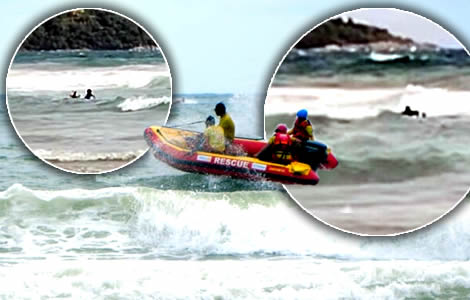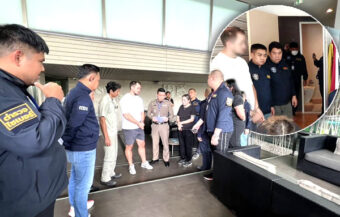Phuket lifeguards saved two French children from deadly rip currents after three drownings at Kata Beach. A new ฿700,000 rescue boat boosts their efforts as tourists ignore red flags. Lifeguards warn: respect the sea, obey warnings, and stay safe this monsoon season.
On Friday, five lifeguards at Kata Beach in Phuket acted fast to save two young French kids caught in deadly rip currents. Their quick response pulled the 12-year-olds back from the brink. This rescue follows three tragic drownings at nearby Karon Beach in June, where rip tides claimed three lives. On Monday in Patong, the local Rotary Club dropped a ฿700,000 rescue boat and gear into lifeguards’ hands. Phuket’s beaches are stunning but deadly, and far too many tourists have paid the ultimate price. Lifeguards know safety can’t wait — they need better tools and support to fight back against the sea’s dangers.

Phuket’s beaches saw both tragedy and heroism this June and July. In June, deadly rip currents at Karon Beach claimed three lives. Then, on Friday, lifeguards at Kata Beach struck back against the raging sea. They rescued two French children in a tense ocean emergency. These events highlight the risks of ignoring red flag warnings and the lifesaving work of trained rescue teams.
On July 11, Kata Beach lifeguards saved two French siblings from drowning. The 12-year-old boy and his twin sister entered the sea alone. Their parents, napping nearby, were unaware of the danger. Although red flags flew clearly, the children went in anyway.
Within minutes, a strong rip current pulled them away from shore.
Lifeguards rescue two French children after dangerous rip currents pull them from Kata Beach shore
Fortunately, lifeguard Mr. Arm spotted the children quickly. He and his team sprang into action. They grabbed rescue boards and paddled hard through rough waves. Luckily, they reached the exhausted children in time. The team brought them safely back to shore and performed quick medical checks.
The parents were stunned and deeply grateful. They offered a cash reward, but the lifeguards declined. Instead, they explained the red flag system. They pointed to the multilingual signs posted along the beach and warned the family to follow flag warnings at all times.
Significantly, this dramatic rescue came shortly after three drownings at Karon Beach in June. All three victims ignored red flags. Between June 10 and June 28, powerful rip currents proved deadly.
On June 28, 34-year-old Japanese tourist Mr. Hikaru entered the sea with his wife. Despite high waves and warning flags, he went in. Moments later, a rip current dragged him away from shore. His wife screamed for help. Lifeguards rushed in and performed CPR. Sadly, the tourist was pronounced dead on the beach.
Tragic drownings at Karon Beach in June underline the dangers of ignoring clear red flag warnings
Just eight days earlier, on June 20, Russian tourist Nikita Tretyakov drowned. He had entered the surf with his teenage son. Witnesses saw him pulled under and vanish. Lifeguards located him about 100 meters offshore. They attempted CPR, but it was too late.
Earlier that month, on June 10, Albanian tourist Daniela Idrizi also drowned. She had just arrived in Phuket with her husband, Mohammed. Daniela entered the ocean soon after arrival. Mohammed watched in horror as she was swept away. Lifeguards searched for nearly an hour before recovering her body. She died later at Chalong Hospital.
Each of these deaths happened under red flag warnings. The sea was visibly rough. Yet the victims entered the water, either underestimating the danger or unaware of the flag system. In every case, strong rip currents were the cause.
Rip currents are powerful channels of water moving away from the shore. From May to October, monsoon winds make them more frequent and deadly. Unfortunately, many swimmers panic and try to swim against the current. That can be fatal. Instead, experts advise floating and swimming parallel to the shore.
Many tourists unaware of rip current dangers despite clear warnings and lifeguards’ constant vigilance
However, many tourists do not know this. In many countries, beaches lack such currents. Therefore, visitors assume that swimming skills are enough. That false confidence can lead to disaster.
Lieutenant Colonel Charas Lempan of Karon Police in July confirmed that lifeguards did everything possible. He emphasised that red flags had been clearly posted. Emergency medics reported that all victims were unresponsive when recovered.
Daniela Idrizi’s husband stayed by her side throughout the rescue efforts. Later, he coordinated with local officials to return her remains home. The tragedy was worsened by the fact that they had only just arrived in Phuket.
Meanwhile, Phuket lifeguards remain on high alert. They check sea conditions daily. They place red flags every morning. Lifeguards patrol from sunrise to sunset, watching swimmers and warning beachgoers.
New rescue boat donated to Phuket lifeguards to help save lives during dangerous monsoon season
New tools are helping them save lives. For instance, on July 7, the Rotary Club of Patong Beach donated a rescue boat to local lifeguards. The GEMINI GRX 420 vessel, worth ฿700,000, was supplied by Tonsai Marine Services. It is built from durable Hypalon rubber and resin.
A 30-horsepower Suzuki engine powers the boat. It carries essential rescue gear and safety equipment. Thus, the vessel helps lifeguards respond faster, even in heavy surf. After the donation ceremony, lifeguards practiced live rescue drills using the boat.
Phuket MP Chalermpong Saengdee attended the event. He praised the partnership between the government, NGOs and private business. He said such collaboration will save lives, especially during the monsoon season.
Rotary Club President Alexander Longman said the donation was part of a broader mission. The club also supports swimming lessons, vision screenings, and scholarships for local children. Daniel and Warangkana Kisby of Tonsai Marine expressed pride in helping keep Phuket’s beaches safer.
Phuket records 30 to 40 drownings yearly, with Karon Beach especially dangerous due to hidden rip currents
Each year, Phuket records 30 to 40 drownings, most during the monsoon season. Many victims ignore red flags or misread sea conditions. Alarmingly, lifeguards report that some even swim after drinking.
Karon Beach is especially dangerous. It has strong waves and wide open shores. These features create fast, hidden rip currents. The water may appear calm, but can turn deadly in seconds.
Third loved one and tourist downed off Karon Beach in dangerous rip tides in just 18 days on Saturday
48-year-old Russian tourist drowns swimming off Karon Beach with red flags raised warning of danger
Egyptian tourist’s harrowing ordeal after losing his wife on Karon Beach on Tuesday hours after arrival
Consequently, lifeguards stress several rules: never swim alone, stay near lifeguard stations, and always obey posted warnings. If caught in a rip current, float, stay calm, and swim parallel to escape. Never try to rescue someone without training. Instead, alert lifeguards and throw them a floating object.
Red flags mean no swimming. Ignoring them has already cost lives this season. Lifeguards continue to train, educate, and respond. However, tourists must also act responsibly. The sea is beautiful—but it demands respect.
With greater awareness, stronger safety efforts, and faster rescues, Phuket hopes to reduce beach fatalities. The message is simple and urgent: when red flags fly, stay dry.
Join the Thai News forum, follow Thai Examiner on Facebook here
Receive all our stories as they come out on Telegram here
Follow Thai Examiner here
Further reading:
48-year-old Russian tourist drowns swimming off Karon Beach with red flags raised warning of danger
Loony pot-smoking German who terrorises dentist clinics on the run in Nakhon Ratchasima. Arrested
29-year-old Indian tourist jumped to his death in Bangkok’s Sukhumvit area. Cannabis found in room


















